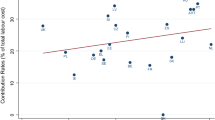Summary
In this paper a formula is introduced for measuring the redistributive impact of public pensions over the life cycle of different income classes. This measure takes account of redistributions of lifetime incomes within a generation, but not of redistributions which are purely intertemporal for one individual and can be used for different pension systems. An empirical application is given with data on the Dutch income distribution. It appears that the redistributive impact of the public pension is determined by the form of the age-income profile, economic growth, the real rate of interest and the length of the working life for different income classes.
Similar content being viewed by others
References
Aaron, Henry (1966) ‘The Social Insurance Paradox,’Canadian Journal of Economics and Political Science, 32, pp. 371–374.
Burkhauser, R.V. and J.L. Warlick (1981), ‘Disentangling the Annuity from the Redistributive Aspects of Social Security in the United States,’Review of Income and Wealth, 27, pp. 401–421.
Verbon, H.A.A. (1984),On the Independence of Financing Methods and Redistributive Aspects of Public Pension Plans, University of Amsterdam.
Author information
Authors and Affiliations
Rights and permissions
About this article
Cite this article
Verbon, H.A.A. Measuring the redistributive impact of public pensions. De Economist 133, 87–98 (1985). https://doi.org/10.1007/BF01675964
Issue Date:
DOI: https://doi.org/10.1007/BF01675964




